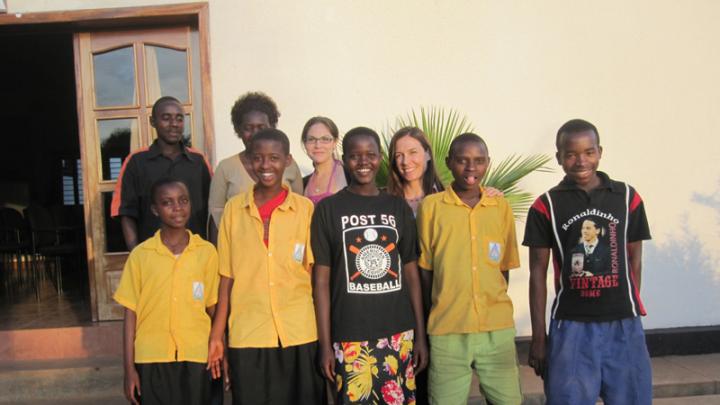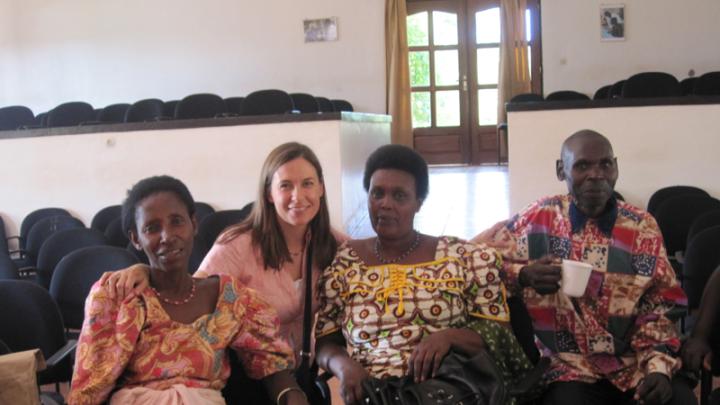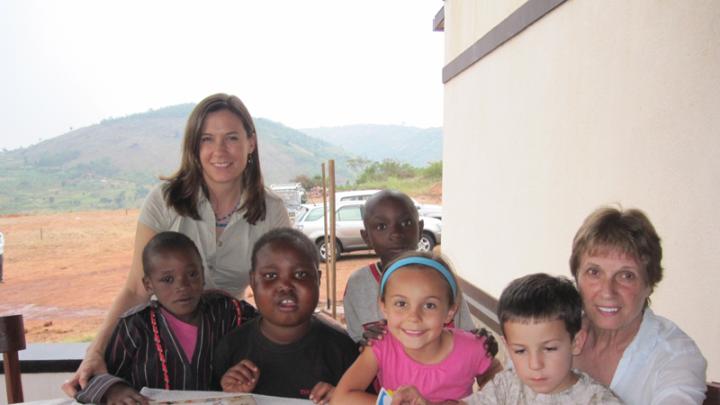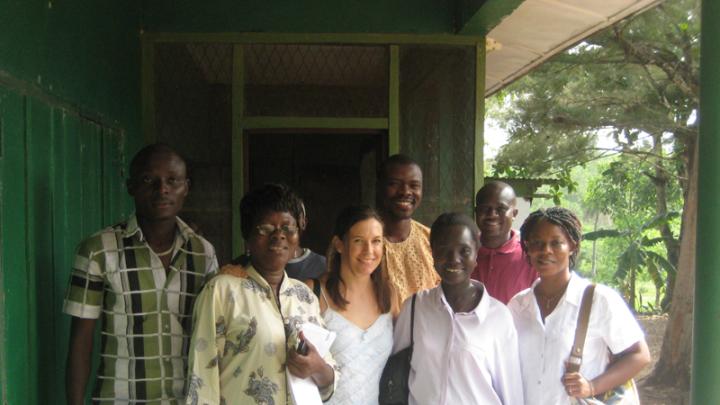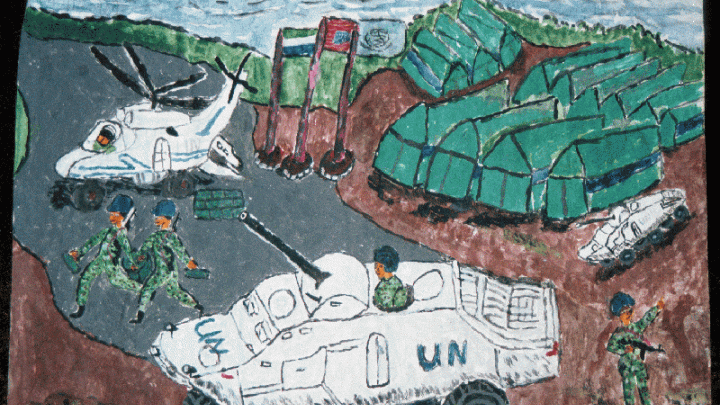Assistant professor of child health and human rights Theresa Betancourt, the director of Harvard’s Research Program on Children and Global Adversity, is the subject of a profile in the November-December issue. Here are excerpts from an interview with Betancourt.
You have research projects in Sierra Leone, Rwanda, and India. How do you navigate cultures that are so different from your own and so different from each other, and get people to trust you enough to discuss mental-health issues?
In none of these places do I go and do it alone. For instance, in Sierra Leone, I have a colleague, Moses Zambo, whom I’ve been working with since the project began in 2002. I couldn’t do it without him. And then everyplace I work, I create long-term relationships. Early in my career, I would respond to humanitarian emergencies, go someplace and be out in a few weeks. I loved it, but I found it dissatisfying not to deepen the connection, deepen the knowledge. With my projects now, I like to learn what I can of the language, learn what I can of the culture. I love to go back and see old colleagues again and again.
I’ve been working in Sierra Leone for so long now that I know the U.S. ambassador. When we were there in January, the ambassador hosted a dinner for us at his home and invited the First Lady of Sierra Leone, the head of the World Bank, the head of the United Nations Development Programme, several ministers, and several leaders of large nongovernmental organizations (NGOs) to highlight our research and talk about the implications of funding programs and policies for youth. To me, that was such a career highlight, to have our research shared in that way, at that level. The First Lady left that meeting and said, we’re going to get this mental-health policy passed.
Tell me about your family background. How has that influenced your career?
My father, who was from Pennsylvania, had been in the Peace Corps in Ethiopia. That experience was very transformative for him, so afterwards, to just go back to the Midwest and take a teaching job wasn’t exciting. He wanted to continue to contribute to a struggling community and he was interested in cultural diversity. In the mid 1960s, they were recruiting teachers to go and live in indigenous communities, small villages, in Alaska, and so my parents went.
They ended up in Bethel, Alaska, which at the time had a population of 3,000, about 80 percent of them Yup’ik Native Americans. That’s where I was born, in a Bureau of Indian Affairs hospital. Public health was part and parcel of life there—there were rampant public-health problems. You had this traditional way of life, and people had really been disempowered in the Native community. There were years when Bethel topped national per-capita crime rates. That’s what happens when you mix despair and loss with alcohol, firearms, and a scarcity of jobs, because their subsistence lifestyle of hunting and fishing was transformed with the arrival of people from the lower 48.
The experience of growing up amid this other dominant culture was very influential for me. When I was little, a lot of my babysitters were Yup’ik. I used to speak Yup’ik. Now I only speak a few words because I don’t use it anymore, but I grew up with a deep respect for this different world view.
My parents were both very involved in social-justice-related work. My mother helped found the first early-childhood center in Bethel. She would fly out on these single-engine planes, to villages of 100 or 200 people, and she would see babies born with fetal alcohol syndrome, babies exhibiting signs of failure to thrive because they lacked engagement with their parents. I remember there were kids who came to our house so my mother could help connect their families with services, and the kids had flattened heads from lying in the crib and not being picked up. So very early on, I became interested in child development and child mental-health issues, especially issues like depression and trauma, but also the question of resilience—how people went through difficult situations and managed to do OK.
You have a master’s degree in art therapy and worked in that field before attending the Harvard School of Public Health (HSPH). Tell me why art therapy interested you and how it led you to your work in public health.
In college I volunteered for a program called Upward Bound, which is for teenagers who would be the first in their families to go to college. A lot of the kids in the program are refugees, and I especially enjoyed working with them and learning about the places they were from, their cultures. But there were also many situations where there was a language barrier, and so using language alone was insufficient. So I would set up art activities—we would paper an entire room, the walls and the floor, and we’d bring in some big pots of paint. These kids were going through all kinds of emotional stuff during adolescence, and it was such a great way for them to express themselves.
During college, I also volunteered for a crime-victims’ assistance program. I would spend time with kids while, for example, there was a child-sexual-abuse trial going on where their families were involved. My role wasn’t to do counseling; I would just spend time with the kids drawing. There’s a level of communication you can engage in when you draw out a story or make a book about your life or express a feeling using paint, that you can’t access using words when you’re an eight-year-old.
To be honest, when I was younger, I don’t think I really understood what public health was. So many people misunderstand it. They think it’s all about SARS and salmonella outbreaks, handwashing and malaria control. I knew nothing about the health-promotion and prevention side of public health.
After finishing the art-therapy degree, I worked in child mental-health services and school-based mental health in Oregon. I had started to learn Spanish as well as French, so I was working with a lot of immigrant families, including some refugee families. I started to think—we’re really good at this Band-Aid thing we’re doing, helping kids recover from trauma, but why are so many kids being exposed to abuse and neglect and trauma in the first place?
I took time off from direct service in mental health, and I came and volunteered at a human-rights conference at HSPH. I wanted to understand more about the human-rights approach—the idea that kids all have the right to safety, to have access to education, but these needs weren’t being met.
I also went to work as a senior intern for the United Nations high commissioner for human rights. That came about through some contacts related to indigenous peoples in Alaska. I got involved with the Graça Machel study (named for the former First Lady of Mozambique, who oversaw the study and is known for her advocacy for children’s rights). This was a major study on the impact of armed conflict on children, and it was an amazing intersection of child health, trauma, public health, and human rights. They were looking for people who could go into the field and set up programs for kids. I was asked to go to the Democratic Republic of Congo; I was asked to go to Kosovo. I thought, “I don’t know this culture. How could I go and set up a mental-health program and think that I could make a difference?”
What I knew I could do instead was facilitating people getting back to doing what they naturally do—so in a refugee camp, you find the people who used to be teachers. You identify youths who are leaders among their peers. You say, “Teachers—what do you know how to teach? Youth leaders—what do the kids here want? How can we set this up?” You lead the process based on the inherent strengths of the people you are serving. You create a sense of structure and a sense of hope, and you help people get back to something which is a huge priority in their lives, which is education. I did that first with the International Rescue Committee in Albania with Kosovar refugees, in 1999, and after that in several other places.
How do you juggle projects in such far-flung places with your work in Boston?
When I was a graduate student, I used to get teased by my professors, because every January I’d say, “I’m going to Albania” or “I’m going to Russia” or “I’m going to Ethiopia.” Then I’d come back and work on my dissertation. It’s very easy before you have kids. Once you have kids, it’s totally different. I’m lucky to have a husband who understands and is interested in the same kind of work, so we try to balance and take turns.
Tell me about your family.
My husband (associate professor of medicine Joseph Betancourt) directs the Disparities Solutions Center at Massachusetts General Hospital. He focuses on racial and ethnic disparities in healthcare, so his work and mine are very synergistic.
We have two children: Anna is eight and Joey is six. They were able to come with me to Rwanda last summer. They got to go into a village and into people’s homes. My daughter was riveted, trying to learn words in Kinyarwanda, taking it all in. She said, “Mom, this family’s so poor that the kids can’t go to school—really?” It actually highlighted the developmental difference between my daughter and my son, because around age seven kids become able to think more abstractly. My son was just like, “Mom, I’m hot. I’m going to get in the car.”
You work with some very troubled groups of children: former child soldiers, children who have lost family members to genocide or HIV, homeless children living in a train station. How does the work affect you emotionally, and what do you do to deal with that?
I think it deepened my dedication to these issues when I became a mother. I was working in the war-affected region of northern Uganda in 2004 and 2005, and I remember going to these interim care centers for former child soldiers, and a lot of the girls had been the victims of repeated sexual violence and had ended up getting pregnant. They had had these babies in the bush, on the run, in their teens while living with a rebel group, with no role models on how to take care of a baby, nor did they want those babies. I remember meeting teenage moms who looked so depressed and despondent, and their babies were crawling around in the mud and crying, and they had all sorts of flies on them and runny noses, and no one was picking them up. I remember getting very upset: “Whose baby is that? Somebody needs to pick that baby up!” I just had this maternal instinct.
But I think for me, it just made me feel all the more that we have to address these issues, that those of us who have passion for this work can make a huge difference. If your treatment for a parent can change the life trajectories of the whole family, you can accomplish something tremendous.
In India, you work with an organization that operates 36 daycare centers at construction sites—but nationwide, there are 40 million migrant construction workers, most of whom travel with families. Do you ever get discouraged because the needs are so vast?
I recently went to a U.S. Agency for International Development meeting, and it was very exciting to me because it brought some of the big development funders into the same room with the National Institutes of Health, and got the people who pay for top-tier research really starting to talk to each other, when historically, they’ve operated in isolation.
I think in coming years, this is going to be really important, and this is squarely where I place my work. The evidence base, the political will, and social strategies to enact programs and policies that benefit vulnerable children and families—you really need all three. [This model was formulated and promoted by the late Julius Richmond, who was a professor of health policy at Harvard and served as U.S. surgeon general from 1977 to 1981.] I think there’s a great deal more work to be done, particularly in asking how children can thrive, and not just survive, in many countries around the world. I think India’s an exciting place right now because it is a tremendous part of the world’s population and a tremendous actor in the global economy, and it has a new, integrated child-protection scheme rolling out. It’s an exciting moment, but the challenges are tremendous.
